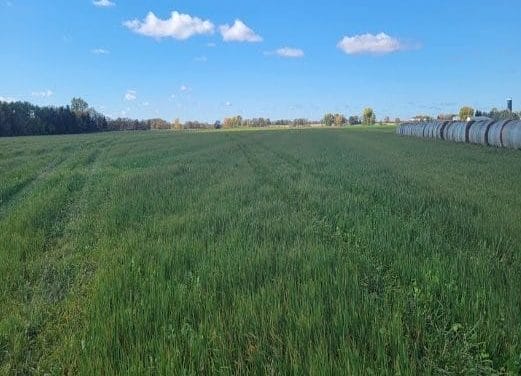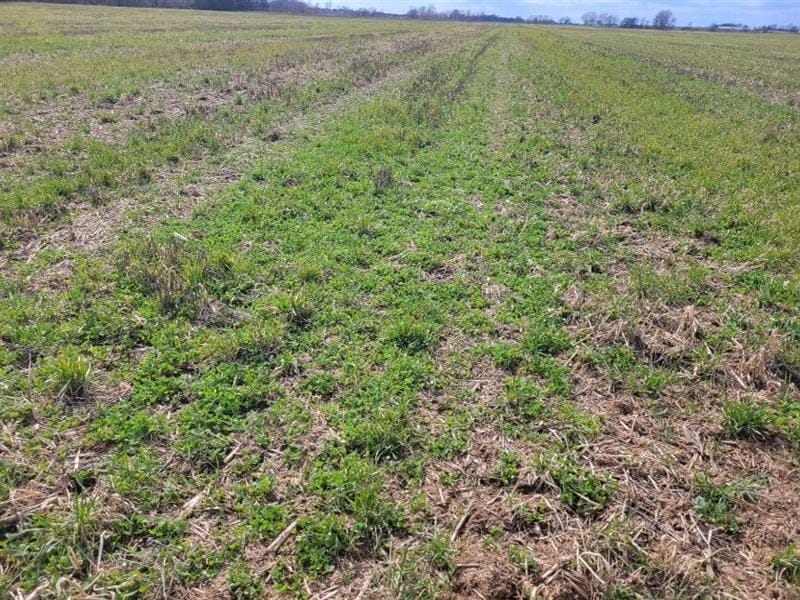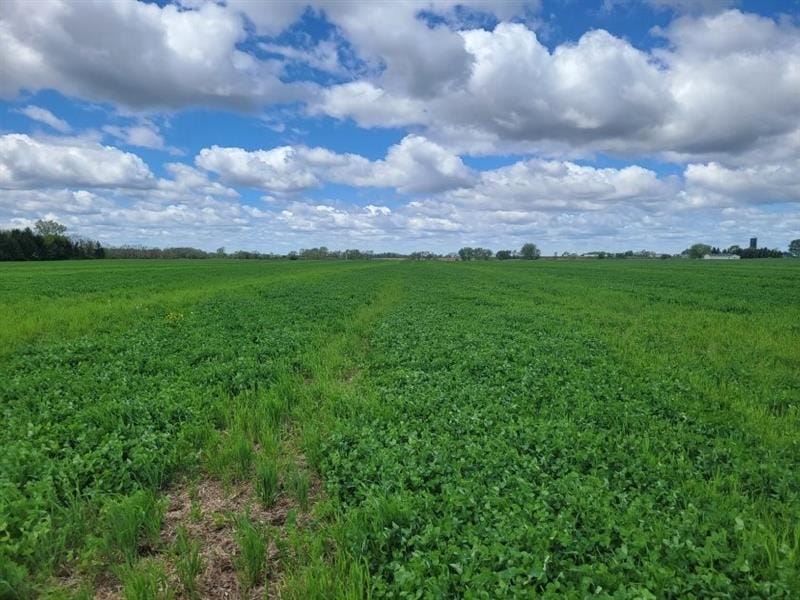Unlocking the Potential of the Soil: Boosting Forage Nutrition With Extended Rotations
Josh Hiemstra is a third-generation dairy farmer who operates Hiemstra Dairy Farm with his wife, children and father in east central Wisconsin. On their 790-acre farm, the Hiemstras grow corn, soybeans, wheat, alfalfa and other forage mixes. In addition to milking 180 Holsteins, they finish 120 head of Angus cross-bred beef cattle. Josh also does custom work, including making forages for other farms.
Last year, Josh participated in Practical Farmers’ small grains cost share, growing winter wheat and following it with a cover crop mix containing a legume. His recent farm rotations focus on building soil health and nutrition by extending and diversifying crops to reduce the need for additional inputs.
Nutrient Management: Seeding Multi-Species Cover Crops
Josh’s preferred cover crop mix to plant following winter wheat consists of oats, radish and red clover, each lending a specific benefit in managing the farm’s soil quality.
“I really like the red clover to get that free nitrogen. The radishes sequester the nutrients from manure applied during the summer so that by the time I terminate in the spring and plant corn, those nutrients are there, ready to go in the soil.”
Josh notes radishes are also great for dealing with compaction in the soil. As for the oats, he says, “They are just really quick to establish and a natural weed suppressant.” Though the oats and radishes terminate with freezing temps, the clover lasts through the winter and its growth takes off in the spring with all the nutrients boosted from the other species.
In fall 2023 and again in spring 2024, Josh took biomass samples of one of his fields planted with the oat-radish-clover mix in 2023 following winter wheat harvest. He did this by clipping the plants within a 1.5-by-1.5-foot area and sending those clippings to a lab at the University of Wisconsin-Madison.
The nutrient analysis for both tests showed the relative forage quality in the 190s. “Normally, beef quality hay is around 100 to 120, with middle-of-the-road forage quality being around 150 to 160, and good forage is around 180-250. It was some pretty good stuff!”

Josh’s oat-radish-clover cover crop mix following winter wheat. Photo taken by Josh Hiemstra, October 2023.

Red clover cover crop continuing to grow in the spring after oats and radishes winter killed. Photo taken by Josh Hiemstra, April 10, 2024.

Biomass of Josh’s cover crop mix increased significantly in 30 days between April 10 and May 9, 2024. Photo taken by Josh Hiemstra, May 9, 2024.
Ensuring Nutrition at Planting
To meet the nutrient needs of his soil and the nutrition needs for the cattle consuming his forage mixes, Josh applies various fertilizers and biologicals at planting. Tanks located on the planter contain potassium sulfate, boron and nitrogen that are applied to his fields at seed depth with precision planting jets.
Smaller tanks contain a carbon-based liquid starter consisting of a 7-21-3 mixture. Josh also applies a liquid seaweed product. He says, “The liquid seaweed regulates the hormones, or plant growth regulators, and relieves stress in especially dry, wet, cold or any other conditions that could be considered stressors.”
Josh additionally uses Bio-Gel, a powder that turns to a gel when mixed with water. It is applied directly to the root zone and helps to retain moisture there. “When there’s proper moisture in that zone, the biological activity makes the nutrients you add and everything that’s already in the soil available to the plant.”
A Healthy Mix of Hay
Forage quality is of great concern to Josh as he seeks to maintain cow health and increase milk production. Primarily using his preferred hay mix of 10 pounds alfalfa, 5 pounds perennial ryegrass, 5 pounds red clover and 2.5 pounds of a diversified grass mix, the cows’ diet consists of about 65-70% forage. Josh averages about 90 pounds of milk production per cow per day from two milkings, a notable increase from five years ago (2019) when he averaged around 75 pounds per cow.
“I believe every plant can serve multiple purposes, contributing not just to yield, but also to soil health and ecosystem balance,” says Josh.
Josh’s forage mix includes species with a variety of root lengths and types, adding diversity and resiliency below ground as well as above. “Your clover is a branch root, your alfalfa is a tap root and your grasses are long fine roots.” He believes that the roots build up the biology in the soil, making nitrogen, phosphorus, potassium and some micronutrients more available to crops. He then supplements calcium, sulfur, boron, carbon and biologicals.

Josh shows how the soil clings to the roots in his rye field in spring of 2024, even after an unusually dry winter and early spring. Photo taken by Josh Hiemstra on April 10, 2024.
“What small grains have done for our soil is quite remarkable,” Josh says. He recognizes how vital small grains are to improving the health of his herd. By expanding and diversifying his rotation, he can gain the necessary nutrition through plants rather than through added inputs. “By feeding the soil and feeding your cattle something they don’t have to work very hard to produce from, you make everything more efficient. Getting more acres and more land isn’t always the way to make more money. Getting more out of what you already have can be.”
Additional Resources
- This blog recaps a small grains shared learning call from June 2024. Learn about and register for upcoming shared learning calls and read other recap blogs from past calls.
- Get the latest updates on new small grains related blogs, research reports, events and other timely resources by subscribing to Small Grains News, our monthly small grains e-newsletter.
- 2020 blog: Maximizing Forage Production with Summer Annuals in an Extended Rotation
- 2020 blog: Using Small Grains to Increase Dairy Feed Tonnage and Quality
